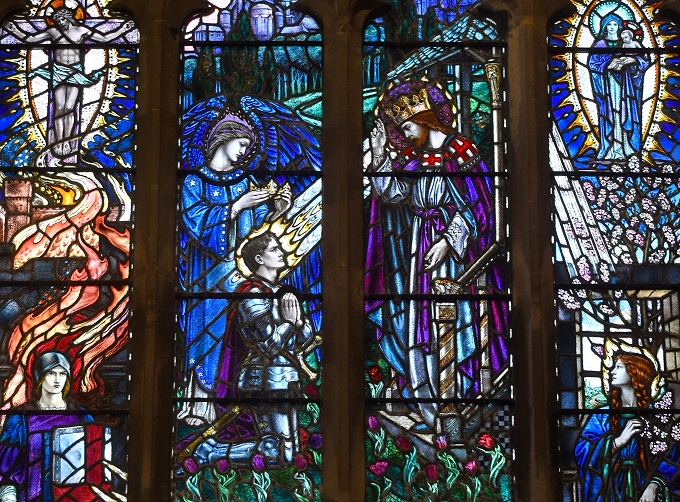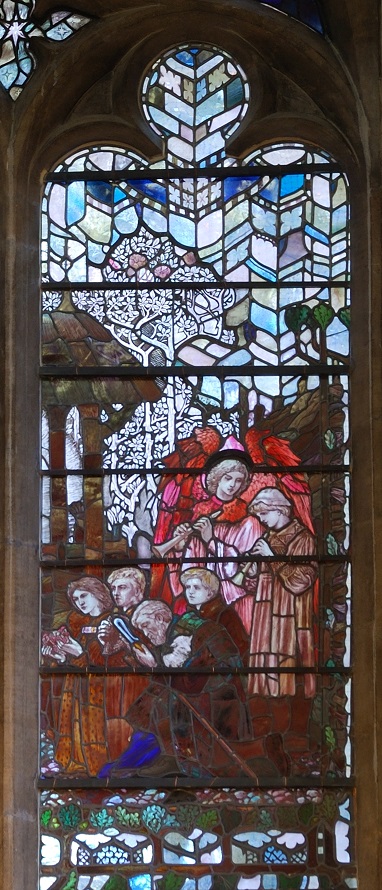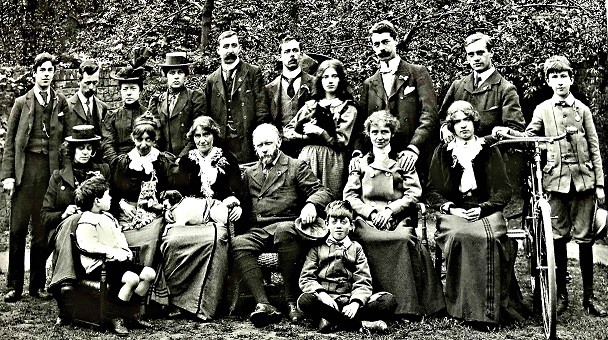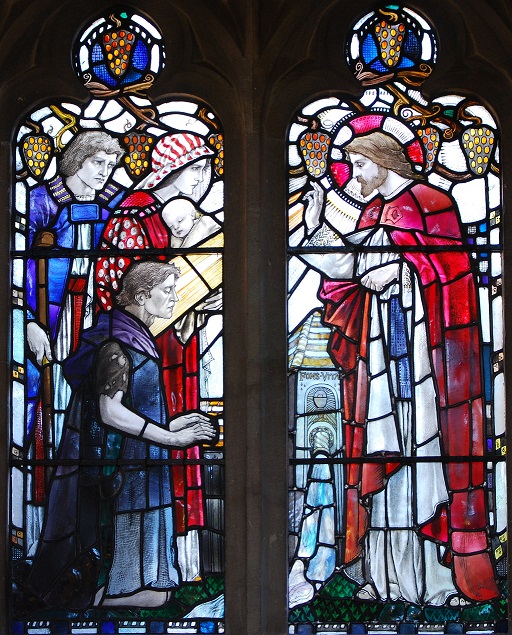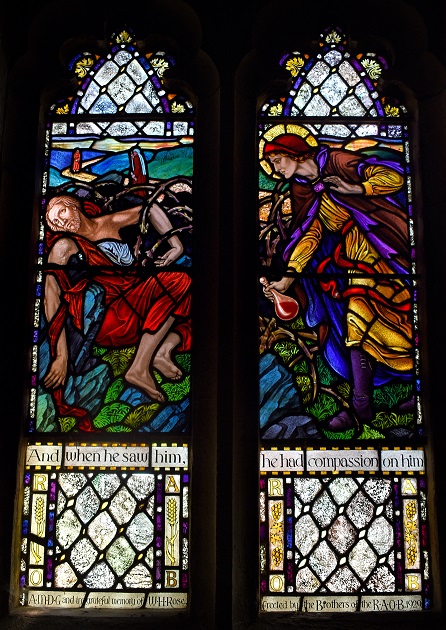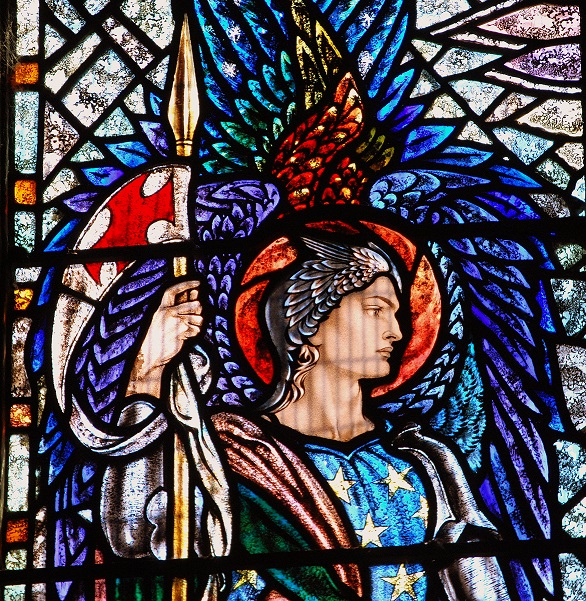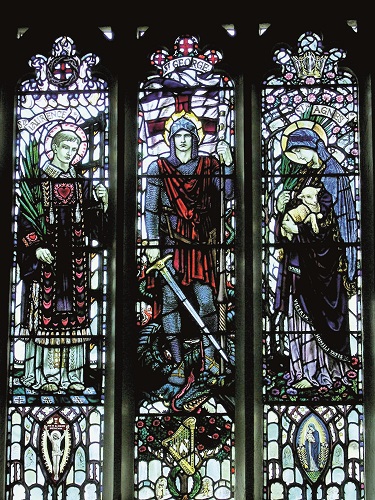Karl Parsons
and the rise of Arts & Crafts stained glass
Jonathan Taylor
Karl Parsons’ four-light memorial window in the church of St Mary the Virgin, Tenby, Pembrokeshire to a soldier killed at Irles, Somme in 1917. In the main part of the window a kneeling warrior is blessed by Christ the King and crowned by an angel, and in the lights on either side stand Fortitude below a vision of the crucifixion and Hope below a vision of Mary. (Photo: Jonathan Taylor)Karl Parsons (or ‘Charles’ as he was named at birth, in 1884) was one of a new wave of stained glass artists who rose to prominence in the early 20th century. Like those of his mentor, Christopher Whall (1849–1924), Parsons’ images explode onto the glass with brilliant colours and textures, and although the compositions still respect the predominantly Gothic church architecture around them, they are radically different from those of their predecessors.
In the late 19th century, almost all new stained glass in churches was of the Gothic Revival. Designs were heavily stylised to suit the surrounding church architecture, typified by saints surrounded by painted gothic canopies, and areas of flat surface pattern with repeated medieval motifs.
Production was dominated by large companies like CE Kempe, Clayton & Bell, and Heaton Butler & Bayne who would employ several designers and often replicated previous designs in their new commissions.
Design and construction were carried out by different people, so although individual designers were responsible for the initial design, this was then skilfully transferred to the glass by artists, apprentices and technicians. Thus the brush strokes and details we see on these Gothic Revival windows were not the work of the original designers, but of the artists and craftspeople employed by the firm for this purpose. Coloured glass was chosen by them to suit the design.
Arguably, this approach suited the church architecture of the period and the scale of production required to meet demand, but there was also a degree of complacency. This division of labour stifled innovation.
Edward Burne-Jones’s work for Morris & Co is one of several designers whose work stands apart from the more formalised windows of the Gothic Revival, but like the larger firms, Morris & Co employed specialist craftspeople to transfer the design from cartoon to glass, to select the glass, cut, paint and fire it, and finally to lead the whole light. Burne-Jones was not the client.
Towards the end of the 19th century this dominance of ‘trade’ over ‘art’ was increasingly being questioned. In his publication Stained Glass as an Art (1896) Henry Holiday (1839–1927) was heavily critical of the system and the work it produced. By then Holiday was already an established stained glass designer, first for the London firm of James Powell & Sons and then, from 1890, as an independent designer. Working from his own studio in Hampstead where he employed his own artists and craftspeople, Holiday found the freedom he needed to explore less formal compositions and to experiment with the delineation of leading lines and the use of coloured glass.
Christopher Whall was another key player in the revolution in design and production that followed. As a stained glass designer and then as a teacher at London’s Central School and the Royal College of Art, Whall inspired a generation of Arts & Crafts artists, including Karl Parsons, Margaret Aldrich Rope (cousin of Margaret Agnes Rope) and Alexander Strachan, as well as his own daughter Veronica Whall, and many others.
The Rise of Arts and Crafts Stained Glass
Christopher Whall (centre, seated) with students, assistants and members of his family in 1900. Karl Parsons is first on the left next to Alexander Strachan and Mary Hutchinson. (Photo: unknown photographer, see Peter Cormack, Arts and Crafts Stained Glass)According to Peter Cormack (see Recommended reading), Christopher Whall’s moment of epiphany as a stained glass artist came in 1887 when an article appeared in the Century Guild’s journal Hobby Horse (1884-92) on the work of another independent artist, H A Kennedy, who was designing and creating his own windows. On the advice of its author, J Aldam Heaton, Whall opened his own studio and he quickly rose to prominence when he exhibited nine items at the 1888 Arts & Crafts exhibition including cartoons for stained glass and panels of lead tracery.
Detail showing the thickness of glass and a section of the lead used by Parsons for his 1919 memorial window at East Harptree, Somerset (Photo: Holy Well Glass) An early discovery of Whall’s was a new form of irregularly shaped glass which had been developed for the architect E S Prior by the firm of Britten & Gilson. Called ‘Prior’s Early English’ glass, it was made by blowing glass into a metal box, so the hot ballooning bubble was moulded with five flat sides and a curved top. Once removed from the metal mould, the glass could be cut neatly into five flat sheets. Because the glass had stretched furthest into the corners of the mould, the inner face of the sheets was slightly convex, thinning to each edge.So, as well as variations in thickness and colour, Prior’s Early English glass also had a lenslike quality that focused the light, adding sparkle and movement. This appealed to Christopher Whall and the generation that followed. However, the small size of the pane meant that a lot of leading was required, reducing the amount of light.
Britten & Gilson and James Powell & Sons were unusual in that both firms made the glass for their stained glass windows, and the two found themselves well placed to work with the new artists of the Arts & Crafts movement. Both developed new types of glass with variations in colour and thickness that suited the movement and encouraged experimentation. A further company, Lowndes & Drury, formed in 1897 with the specific aim of working for the Arts & Crafts artists and to exploit the potential of the new forms of glass. Both its founders had worked at Britten & Gilson, Mary Lowndes as an artist and Alfred Drury as a glazier.
In 1896 the Central School of Arts & Crafts (now St Martin’s) opened in London under the leadership of the architect W R Lethaby and sculptor George Frampton. Christopher Whall taught evening classes in the design of stained glass from the start, and he brought in Alfred Drury to teach the practical aspects of cutting and leading. A stained glass course was then established at the Royal College of Art and by 1901 both Whall and Drury were officially teaching on this course too.
Jesus the Healer (1908) is one of five windows designed by Karl Parsons for St Alban’s church in Hindhead, Surrey from his studio at the Glass House. (Photo: Andrew Loutit)For his early commissions Whall had been painting his designs directly onto the glass itself, with the help of just a few assistants. Now he took on apprentices from his evening classes so they could continue their training. These included both women and men, among them the watercolourist Beatrice Parsons, and she was later joined by her much younger brother Karl, who in 1899 was just 15.
At that time Whall would have been working on the windows for Holy Trinity, Chelsea, which was later dubbed the ‘Cathedral of Arts & Crafts Movement’ because its architect, John Dando Sedding pulled in some of the finest designers of the new movement to help furnish and decorate it. Whall was responsible for several windows in the south aisle, including two large three-light windows and several smaller clerestory windows. They were all made by Lowndes & Drury from their house in Park Walk, Chelsea. The Adoration of the Magi and the Shepherds was completed in 1900, so it was probably the first major project that Parsons was involved in.
Details of The Good Samaritan, a two-light window in Pyle, Glamorgan made in 1930 (Photo: Jonathan Taylor) By 1906 Parsons was working from a studio at Lowndes & Drury’s new premises in Fulham, The Glass House, and he retained a studio there until 1930. Initial projects were carried out for Christopher Whall, including windows for St George’s Cathedral in Cape Town, and it was not until 1908 that he completed his first independent commission, a twolight window depicting Christ the Healer for the church of St Alban in Hindhead, Surrey. Over the following two years he made four more windows for the church.
In one light of Christ the Healer Jesus raises his hand in blessing and in the other, a kneeling man receives it in the form of a shaft of light which connects both lights, emanating from Christ’s raised hand but also from the centre of his halo. Two further people, one holding a baby, wait to be healed. The subject and the imagery are highly sentimental, and every detail adds pathos.
Stylistically, the result is very similar to Christopher Whall’s, with exquisitely drawn detail, the use of lead to delineate background patterns and bold colouring. This is not the first work of a developing artist: the work reflects the bold confidence of a designer who has already gained years of experience working with Whall, and who by now had taken over from Whall to teach at the Central School.
Although much of the formal composition of Gothic Revival stained glass has gone, the composition of Parsons’ windows still retain respect for the architectural surround. The figure of Christ dominates the centre of one light, while the two standing people and the central kneeling figure retain a central focus in the other light, which is reinforced by the blue background to the grapes in the top lobe of each light. However, the two lights are connected by the strong diagonal line of the blessing, by the repetition of bunches of grapes at head level, and by the use of a border running down the outside edge of each window and over the top, but not down the central mullion. Partial borders like these are common features of many Arts & Crafts windows, with many variations, such as the stronger top and bottom frames in The Good Samaritan.
Faces in most of Parsons’ stained glass are drawn in monochrome and the influence of photography is particularly obvious here in the shading of the skin tones. Writing in The Sign in 2014, Parsons describes how on the lighter parts such as faces and hands, lines are traced from the artist’s cartoon onto the cut pieces of glass using pigment bound with gum arabic to make it adhere. Then the pieces are temporarily mounted on a large sheet of plate glass in a frame, and ‘waxed up’ with a little molten wax between each piece to secure them. This easel is then hung so that the artists can work using natural light transmitted through the glass from a window. The faces and other parts which are to be shaded are then lightly covered with a ‘matt’, varying in density according to the effect required. This is then softened carefully, without damaging the traced lines, by gently brushing with a badger-hair brush until the film is quite even and flat. This, Parson explained, creates a half-tone through which the lines still show. When it is quite dry, the ‘work is modelled as desired by removing the matt with firm hog hair and fitch brushes’. Where highlights are required, the half tone could be brushed off completely, working the edges to soften the transition. Where sharp details were required, the half tone could be removed with a sharp stick.
By comparison with the faces and skin tones, the treatment of robes and backgrounds is much more abstract. Much of this is created by the rich variations in colour density of the glass used, but often this is supplemented by applying a thick matt layer which is mostly removed to leave a more textured surface, or cut into sharply to provide pattern, movement or sparkle, depending on the object or subject.
For Parsons the Glass House was more than just studio space. It was a hub for a community of like-minded artists, and for the exchange of ideas. Many leading figures in the Arts & Crafts movement used Lowndes and Drury’s services for firing, leading and installing their windows, as documented in Volume XLI of The Journal of Stained Glass. Others rented studio space alongside Parsons, including former Whall students Caroline Townshend and Hugh Arnold, Birmingham School of Art student Margaret Agnes Rope, and the Irish artists Wilhemena Geddes and Harry Clarke. Louis Davis, another of Whall’s students also worked for the Glass House and Peter Cormack notes that Parsons worked with him on at least three commissions, and that the two considered setting up in partnership together. Many of these artists had a highly romanticis+ed view of the Middle Ages that was shared with the Pre-Raphaelites, and Louis Davis in particular was associated with the art movement. Its influence can be seen in much of Whall’s and Parsons’ work too.
Much of Parsons’ later work has a greater density of colour, such as The Good Samaritan, a two-light window in Pyle, Glamorgan made in 1930 (illustrated above). It has been suggested that this stylistic change was a response to his visit to the Cathedral at Chartes in 1924, where he and his brother made a study of the medieval stained glass. The visit certainly had a profound effect on him, and many of his later pieces do contain fewer ‘white’ areas of clear glass.
In 1929 Parsons gave up his teaching post and moved to Shalbourne, Wiltshire to focus on designing stained glass. However, ill health forced him to return to London in 1933 and he died in 1934 at the age of 50.
The work of Arts & Crafts artists like Parsons can be found in churches throughout Britain and Ireland. Most are unlocked during the day and are readily accessible for everyone to enjoy. Photos of many of the finest examples can be found on Flickr, and this is an excellent resource for planning a visit.
Because windows are part of the fabric of a buil ding, serving to keep out the wind and the rain, their importance as works of art is sometimes overlooked. They are irreplaceable, and their maintenance, repair and protection are of the utmost importance. These churches need to remain open and cared for, one way or another.
Recommended Reading
Peter Cormack, Arts & Crafts Stained Glass, Yale University Press, London 2015
The Journal of Stained Glass Vol XLI, ‘The Glass House Special Edition’, BSMGP, London 2017
Nicola Gordon Bowe, ‘Tower of Glass: An Túr Gloine and the Early 20th Century Stained Glass Revival in Ireland’, Historic Churches, Cathedral Communications, Tisbury 2008



